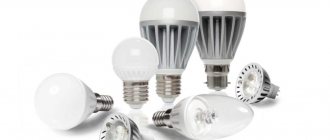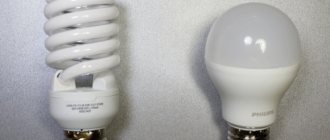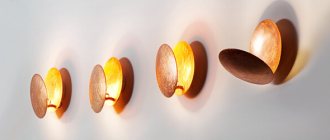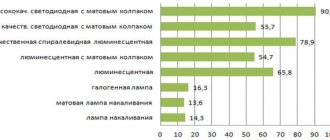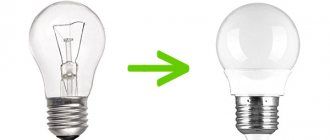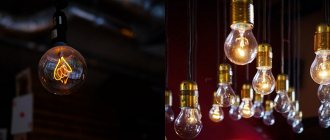Technologies are constantly improving and developing, and more effective solutions are emerging. The same applies to equipment that makes life easier: it is adjusted and supplemented with new functions. Modern lighting devices are significantly different from those of a few years ago. Standard incandescent lamps have been replaced by much more economical, practical and ergonomic 12 Volt LED lamps.
The products have many minor flaws, but constant development and research will ultimately lead to them displacing less effective analogues from the market.
Design
The design of lamps powered by a constant voltage of 12 V differs significantly from traditional incandescent or fluorescent lamps.
We list the main structural elements:
- Glass flask. Usually made from transparent glass (less often frosted) in the shape of a ball or disk. The dome shape allows you to significantly increase the dispersion angle, which reaches 270 degrees. Flat bulbs are used in point light sources for additional lighting. Some devices are used to illuminate interior items, others - for zoning spacious rooms. Spotlights have a minimal dispersion angle - from 30 to 60 degrees.
- LEDs are light sources. They are connected in series with each other, which allows to increase the luminous efficiency of the device.
- A radiator is an aluminum plate that removes heat that is generated during the emission of LED diodes.
- The case is made of durable plastic - it is an excellent dielectric and performs protective functions. Prevents electric shock during installation and removal of the device.
- Driver - stabilizes the voltage by converting alternating current to direct current at 12 V.
- Base. Due to the high popularity of the products, diode lamps are produced with a variety of bases. You can easily find standard products chambered for E27, E14, G4 cartridges. G13, GU10, etc.
The brightness of such a light bulb depends on the number of LEDs and the power of each of them individually. The illumination of products is calculated according to the ratio of 1 lm for every 100 W.
How to connect an LED lamp.
The connection is similar to incandescent and fluorescent lamps - you should turn off the power to the socket and screw the lamp into it.
If you need to connect several LED light sources, the following connection options are possible: serial and parallel.
However, this connection should not be used in practice. Even LEDs from the same batch do not guarantee the same voltage drop. Because of this, the current on an individual LED element may exceed the permissible limit, which can cause the elements to fail.
The serial version requires a minimum number of wires, but is used extremely rarely. The reason for this is two shortcomings. Firstly, when one light bulb burns out, the entire circuit fails. Secondly, the lamps do not work at full power, since when connected in series, the voltage is summed up. Perhaps the only cases where a serial connection is justified are Christmas tree garlands and entrance lighting. In these cases, low power ratings for many light sources are acceptable.
The scheme is quite simple:
- from the distribution box the phase goes to the switch;
- from the switch the phase passes to the LED lamp;
- the neutral wire is connected to the second contact of the last lamp in the circuit;
- The phase wire passes from the lamps to each other.
Serial connection diagram for LED lamps.
The parallel method is used most often. The main advantage is the supply of the same voltage to all light bulbs in the circuit. In the event of a burnout, only a failed light source falls out of the circuit, which is easy to replace.
You can connect in parallel in two ways: beam and daisy chain.
The beam method is reliable. Although this requires a large amount of cable
And it is important to think about the moment of connecting all the elements. Most often, a terminal block is used for this.
On one side, a phase is supplied to its jumpers. On the reverse side, connect the wires coming from the light bulbs. It is recommended to fill the inside of the terminal block with anti-oxidation paste. Also, instead of a block, use twisted wires with soldering.
Diagram of parallel beam connection via terminal block.
When using a loop circuit, the phase and neutral wires from the panel and switch are connected to the first light bulb. From it the cable is fed to the second and so on. Thus, each light bulb (except the last one) is connected to four wires: two phase and two neutral.
Diagram of parallel connection using a daisy chain circuit.
Connecting light bulbs operating on 12V voltage is similar, only a step-down transformer must be included in the circuit.
Diagram of parallel connection of 12V spotlights via a transformer.
Varieties
Based on the power source, light bulbs are divided into two main categories - low-voltage, designed for operation on a 12 V network, and conventional, connected to a 220 V network. There are other varieties - 24, 36 or 48 V, which belong to the category of low-voltage LED lamps. Low-voltage ones differ from regular ones in the use of a driver (aka power supply) that stabilizes the voltage. It can be built into the product design by default or installed separately as an independent element.
The power of such sources is usually low and is in the range of 0.4–8.0 W. Moreover, fractional power values are used more often than whole ones.
Another criterion for classifying 12-volt LED devices is the shape of the glass bulb. The following varieties are distinguished:
- open type;
- devices with flasks of various geometric shapes;
- round flat products similar to a disk.
The most common are SMD type lamps. The brightness of the light flux is selected depending on the size of the product - the more LEDs, the more intense the lighting will be.
Main characteristics of LED lamps and types of bases
LED light bulbs are available in a wide variety of specifications, designated by numerical and letter indices. Models of the second (3157; 1157; 7443; 1156; ba9s; 7440; 7443; 194; 921) and third generation with H7 bases are presented on the Russian market; H11; H4; H8; 9005; 9006; 9012. Bulbs available for CAN specification.
| Marking | Characteristics |
| T20 | T20 is widely known in industry standards under the following sizes: 7440 7441 7443 7444 992A. They are used for turn signals, brake lights, tail lights and daytime running lights. |
| T25 | T25 is widely known under the following sizes: 3156 3056 3157 3057 3357 3457 4157. They are used in the same place as T20. |
| BA15 | The abbreviation BA15 stands for bayonet base with a diameter of 15 mm. BA15 are commonly known by the following sizes: 1156 7506 7527 1157 2057 2357 7528 P21W P21/4W. BA15 are commonly used for daytime running lights and headlights. |
LEDs give car owners more control over lighting settings. Modern LED lamp model numbers are mainly divided into single and double beam functions. In the table below we have shown the size correspondence.
| Type of LED lamps for car | Plinth sizes |
| Single beam | h1, h3, h7, h8 / h9 / h11, 9005, 9006 and 880/881 |
| With two beams | h4, h13, 9004 and 9007 |
Basic selection options
Incandescent lamps have many technical and operational characteristics. We list the main ones:
- Colorful temperature. Its value is in the range of 2700–6500 K. Depending on the specific value, the lamp may emit more cool (white) or warm (yellow) light when illuminated.
- Light flow. This parameter for LED products is usually high and reaches 600 Lm.
- Durability - the average lifespan of lighting fixtures is 50,000 hours.
- Power - from 0.4 to 8 W.
- Availability of driver. In fact, devices operating exclusively from a 12 or 220 V network are rare. Most often, manufacturers produce LED lamps with a wide voltage range - for example, 150–250 V. This means that such devices are not afraid of any serious voltage drops.
- Dimensions. This equipment is often used to replace halogen lamps, so manufacturers strive to simplify the installation process of the product as much as possible and provide more freedom by reducing its dimensions.
- Number of LEDs.
The product packaging usually indicates the shade of light when using the lamps, which greatly facilitates the choice.
How to understand what power LED lamp should I choose?
In recent years, many have been inclined to make a smart decision to switch to LED lamps. It is not only convenient, but also economical. Compared to incandescent lamps, they have many advantages. One of the most important advantages is savings. Try replacing all the lamps in your apartment with LED ones - and you will pay several times less for electricity. At the same time, the quality of lighting will noticeably improve, because the light from these bulbs does not flicker, they do not burn during voltage surges and are completely safe for health. There is only one problem - how to choose?
Have you often stood in the lighting department, trying in vain to find the right LED? Sometimes in such cases, sales consultants approach buyers, who categorically point to the most expensive model and say: “Take this, you won’t regret it, I use these myself.” A familiar situation, isn't it? Usually this only confuses things even more and doesn't help at all. In fact, the choice can be much simpler; you just need to understand the relationship between the power in incandescent lamps or “housekeepers” (if this option is closer to you) and in LED lamps.
That is, as we can see. LED lamps provide a powerful stream of light at lower power. It is due to this that savings can be achieved when using them.
The easiest way is to select a lamp not by power, but by the number of Lumens. This gives a more complete picture of what kind of light flow comes from it. For example, a 5 Watt X-Energy LED lamp has 550 Lumens, which is average between 40 Watt and 60 Watt incandescent lamps. This is quite enough for domestic use. This light bulb will find its use in the kitchen, bathroom, bedroom, living room or hallway. Among the range of lamps of this power, you can choose models with a warm or cool glow. Because this is the most popular option. These lamps are produced, as a rule, with an E27 base.
An equally common option is a 9 Watt LED lamp. Its luminous flux is 850 Lm, which is equivalent to a 75W incandescent lamp. It is intended for more demanding consumers who like well-lit rooms. Such lamps are suitable for a study, office space, library. They provide an even, stable, bright light, convenient for reading or performing delicate work. They are harmless to the eyes and resistant to voltage surges. This makes the use of these light bulbs not only comfortable, but also durable. While conventional and even energy-saving lamps will have served their purpose, the LED lamp will still work, delighting you with its high-quality light. Therefore, their cost is completely justified and appropriate.
The next time you approach the light bulb aisle, you won't be so easily confused. Remember that you need to navigate. First of all, by the number of Lumens, it is from them that the power of the glow can be determined. Therefore, if you like bright light, feel free to take the maximum, especially since you won’t have to pay much for such pleasure. Energy-saving technology for the production of LED lamps allows us to provide a stable and high-quality glow that does not consume a lot of electricity. Such a light bulb is a worthy investment, especially in light of recent events related to currency fluctuations. Therefore, feel free to take it today, because tomorrow it may cost several times more!
You can ask additional questions by phone: +38097 795-09-08
We will definitely answer all your questions as soon as possible.
Power supply for 12 V lamps
Drivers or power supplies are selected depending on the purpose of the lamp. They are classified into the following types:
- Sealed. The best solution for use in the bathroom, bathhouse or outdoors. An excellent option for any room with high humidity levels and the likelihood of splashes.
- Unsealed - installed in rooms with normal humidity levels.
- The driver with an active cooling system is supplemented with a special fan, which allows you to increase the power of the product and reduce its dimensions.
- With a passive cooling system - a radiator is used instead of a fan. They are characterized by silent operation, but the power is limited by the size of the device.
In addition, power supplies are divided according to the value of technical parameters:
- Power. To select the right driver, you need to add up the power of each light source, and then increase the resulting value by 10-15%. This reserve is needed to prevent failure during moments of overload.
- Output current - selected depending on the number of connected light bulbs. A more difficult to calculate characteristic, which must coincide with the required current value for specific sources. The value is affected by the cross-sectional area of the elements connecting the power supply and the lamp.
- Output voltage - in this particular case, the value is 12 V.
Installing LED headlights: different options
From a legislative point of view, the installation of diode headlights will make a fundamental difference in the following cases:
- Factory installed LED headlights. Certification of lighting equipment is carried out by the manufacturer himself; the buyer does not need to worry about anything.
- Installation of LED headlights that are standardly installed on the vehicle by the manufacturer. Re-registration with the traffic police will be required; approval of the installation is not required.
- Installation of LED headlights when the manufacturer did not provide for this type of headlights. Installation approval and re-registration with the traffic police will be required.
Let's consider the last two options, since the first does not require additional explanation.
Installing LED bulbs in halogen headlights
Let's say you are the owner of a regular car with halogen optics, and you want to install LED lamps instead of halogen ones. Let's consider this situation from the point of view of traffic regulations. As you know, car headlights are always made for a certain type of lamp, and are marked accordingly. For example, if you install a xenon lamp in a headlight designed for halogen lamps, we will get a significant “flare” around the edges - the reflector is designed for an almost point source of light at the desired point, while the xenon lamp is a cylinder filled with luminous gas. Therefore, precise focusing of the light flux does not occur, and such headlights will always blind oncoming drivers and everyone around.
So is it possible to install LED bulbs in halogen headlights?
No, since this leads to the implementation of paragraph 3.1 of the Appendix to the Traffic Regulations “List of faults and conditions under which the operation of vehicles is prohibited”
List of faults, clause 3.1. The number, type, color, location and operating mode of external lighting devices do not meet the requirements of the vehicle design.
The punishment for this violation is provided for in Part 1 of Article 12.5 of the Code of Administrative Offenses:
Code of Administrative Offenses of the Russian Federation, Art. 12.5 h 1. Driving a vehicle in the presence of malfunctions or conditions under which, in accordance with the Basic Provisions for the admission of vehicles to operation and the duties of officials to ensure road safety, operation of the vehicle is prohibited, with the exception of malfunctions and conditions specified in parts 2 – 7 of this article, shall entail a warning or the imposition of an administrative fine in the amount of five hundred rubles.
Thus, the maximum fine for installing LED light bulbs is 500 rubles. How will an inspector check the type of headlights on a car? It’s very simple - according to the factory markings on the headlight glass. We talked more about headlight markings in the article Are xenon lamps allowed?
Is it possible to install LED headlights instead of halogen ones?
If we talk about replacing entire headlights with ones designed for LED lamps, then such a conversion is usually possible. We are talking about the re-equipment of a car, which is carried out in accordance with the Technical Regulations of the Customs Union “On the Safety of Wheeled Vehicles”:
75. Verification of compliance with the requirements for vehicles in operation in the event of changes to their design is carried out in the form of a preliminary technical examination of the design for the possibility of making changes and subsequent verification of the safety of the design and technical inspection of the vehicle with changes made to the design. During preliminary technical examination ensures that after changes are made to the design of the vehicle, its compliance with the requirements of this technical regulation in force at the time the vehicle is put into circulation is ensured. During the safety check of the design of the vehicle, it is ensured that after changes are made to the design the safety of the vehicle complies with the requirements of these technical regulations.
That is, in order to legalize the conversion of a car, there are two checks: one of them is before the conversion, and is in the nature of approval: perhaps the desired conversion is not possible at all on the car model in question. The second inspection is carried out after the changes have been made and evaluates the safety level of the structure after the conversion.
Scope of application of 12 V devices
LED lamps for 12, 24, 36 and 48 V with standard sockets E14, E27, G4, GU10 can be used for the home, when organizing lighting systems for vehicles, sales areas, shop windows or office premises. In almost all cases, conventional incandescent or halogen lamps can be replaced with LED analogues.
Most often, low-voltage light sources are installed in rooms with high humidity, including bathrooms, kitchens, saunas, and basements. They are also used for street lighting. LED lamp with G4 socket is mounted in a spotlight. The choice should be made in its favor when arranging suspended ceilings, since LEDs, despite the need to use cooling radiators, heat up significantly less than conventional and halogen devices.
So which is better?
Whether or not to replace halogen lamps with G4 12 V LED lamps in an apartment is, of course, a difficult question. On the one hand, energy savings and a much longer service life of lighting devices on crystals. On the other hand, when replacing, you also need to invest. These are LED bulbs and a stabilizing device - a dimmer. Of course, after a short time the costs will be justified, but this will happen later, and you need to spend it now. Is it possible to give a satisfactory answer to this question? In any case, everyone must decide for themselves.
Advantages and disadvantages of 12-volt lighting
The most important advantage of 12, 24 or 36 V LED bulbs is their high efficiency. During the installation process, there is no need to spend money on placing auxiliary elements or laying protective cable channels. Low voltage makes the devices much safer than lighting devices powered from a 220 V network. This allows the lamps to be used in rooms for various purposes with high humidity levels (basements, swimming pools, bathrooms).
Cost-effectiveness is also achieved during equipment operation. To obtain the luminous flux provided by a 60 W incandescent lamp, a 6-7 W LED light source is sufficient.
Low-voltage LED lamps are suitable for installation in facilities with increased PUE standards associated with a high degree of danger. The most striking example of such an object is a boiler room.
Manufacturers produce products with standard sockets, which simplifies the replacement of halogen and incandescent lamps with LED lamps equipped with an identical holder. In this case, additional parameters must be taken into account, including luminous flux and overall dimensions.
Now let's move on to the disadvantages. In domestic conditions, 12 V LED light bulbs are connected through a step-down transformer, installed in front of the lamp and reducing the voltage to the required values. Step-down transformers can be characterized by impressive dimensions, so when placed in chandeliers or ceiling structures, free space must be provided. It is not always possible to implement such a scheme.
Due to the low voltage, such light sources are characterized by an increased current value. For this reason, the correct length of conductors must be selected. The longer the cable, the higher the resistance. Increasing the latter value negatively affects the quality of lighting.
Algorithm for selecting miniature LEDs
The range of 12 V G4 LED bulbs is very diverse. When determining the appropriate option, you need to understand the purpose and operational features of different types, as well as competently evaluate the basic characteristics of illuminators.
Variety of designs
The first priority is to choose the desired shape of the light bulb.
Among the low-voltage LED models with a 4 mm pin base, five types are mainly used in everyday life:
- capsules;
- corn;
- petals;
- candles;
- disk.
The first group is most in demand. The body has a cylindrical shape and is covered with a transparent or frosted bulb - a diffuser. Such products more often than usual act as a substitute for halogen light bulbs.
Forms of miniature illuminators. Designations for the photo: 1 – capsule, 2 – corn without a flask, 3 – petal, 4 – candle, 5 – disk lamp or “tablet”
In corn, all the diodes are located on an open cylindrical platform. The absence of a bulb allows for brighter illumination and eliminates the possibility of overheating. Like a traditional capsule, corn is installed in chandeliers and lamps.
The main disadvantage is the unattractive appearance when turned off. The corn is selected so that the lampshade covers the light bulb itself.
The “petal” and “candle” models are more often used in vehicle lighting. However, they have also found their application in organizing home lighting - this is spot lighting, creating ceiling or wall luminous patterns.
Flat disk-shaped illuminators are used in luminaires designed to create a directional luminous flux. The illumination angle of the “tablets” is no more than 120°.
In addition to the form factor, low-voltage light bulbs differ from each other in their internal filling - the type of LEDs.
Three options are possible:
- SMD;
- COB;
- Filament.
SMD . Single semiconductor crystals coated with phosphor. The diodes are located on a heat-sinking printed circuit board.
The visible glow angle of one crystal is 20-140°. The main advantage of SMD LEDs is intensive heat dissipation and, as a result, durability.
COB . Structurally, a COB matrix is a set of crystals on one platform, filled with phosphor. Due to the tight fit of SMD diodes, a bright glow is achieved. COB lamps illuminate about 180-220°.
Designations for the photo: 1 – SMD LEDs, 2 – illuminator with COB panel. Models of the second option are prone to more intense heating, and if one diode from the matrix fails, the entire lamp goes out
Filament . Has the most effective light parameters. Many crystals are installed on glass threads, which are then coated with a fluorescent solution. The main achievement of the technology is 360° illumination.
Filament LEDs always have a transparent bulb, and their glow is similar to the operation of incandescent lamps. This option is optimal for creating uniformly non-directional light.
Taking light characteristics into account
Having decided on a suitable shape, you should evaluate the main parameters of the LED light bulb:
- power equivalent;
- light flow;
- glow temperature;
- color rendering quality;
- degree of pulsation.
The brightness of LED light bulbs is characterized by two indicators: power equivalent and luminous flux. The parameters are interconnected.
Using the summary table, you can determine at what power different lamps achieve a certain level of luminous flux, expressed in lumens.
For example, a 40 W incandescent light bulb produces 470 lumens. For a complete replacement, a 6 W LED analog or a 32 W halogen (+) is suitable.
If you don’t have a comparison table at hand, you can rely on the manufacturer’s data - often the packaging indicates the amount of luminous flux and an analogue of power.
In case of lack of information, a rough guide will do: 10 W incandescent lamp corresponds to 1.5 W LED illuminator.
Glow temperature . An important parameter that determines the comfort of light perception and the quality of lighting of the surrounding space. Low-voltage LED lamps operate in the range of 3000-4500 K, which corresponds to neutral and daylight.
The usual incandescent lamp creates a soft, slightly yellowish tint, LED models give a cooler tone.
As the color temperature decreases, red tones predominate in the illumination; as the color temperature increases, blue and greenish shades begin to dominate (+)
The choice of color temperature depends on the purpose of the light bulb and its location. For the bedroom, it is better to choose products with an indicator of no more than 3000 K; for a child’s room, an LED of 3000-3200 K is suitable, and for decorating a work space - 3500 K or more.
Color rendition . Unfortunately, this characteristic is rarely specified by manufacturers of capsule light bulbs. But it is the color rendering index that largely determines the reality of perception of surrounding objects and one’s own reflection in the mirror.
The parameter is expressed in absolute units within 100 and is designated CRI. The reference indicator is sunlight, CRI=1. Incandescent lamps also give good results – CRI=97.
Inexpensive LED illuminators can distort the color spectrum; their CRI sometimes does not reach 70. For a residential area, this figure should not be less than 80
If the data is not displayed on the packaging, then the quality of color rendering is checked experimentally. Place your palm under the glowing light bulb; if it seems grayish, then the product is clearly of dubious quality.
Flicker of light . Another characteristic that manufacturers are in no hurry to share is the degree of pulsation. During operation, LEDs can flicker, creating significant eye strain.
Immediately after switching on, the pulsation is not felt, but with such a glow a person gets tired faster, and vision may deteriorate.
To diagnose the defect, you need to look at the switched-on capsule through the smartphone camera. The presence of pronounced stripes indicates unacceptable flicker intensity.
Strong pulsation is noticeable with peripheral vision. To confirm your guesses, you can perform a pencil test. A trail of many contours clearly demonstrates the flickering of light
According to SNiP standards, the pulsation level for a home should be within 30%, and for workplace lighting - up to 20%.
A capacitor is responsible for smoothing out flicker in low-voltage LEDs. Whether the element will cope with its task depends on its capacity. For an LED lamp with a power of 1.2-2 W, you need a capacitor of at least 100 μF.
You can calculate the actual capacity of an element from its markings. Multiply the first two-digit number by the number encrypted in the third (6 means 1 µF, 7 - 10 µF). Letter marking is the operating voltage of the capacitor.
Calculation example for module 476 C: 47*1=47 µF. Such a capacitor will not completely block the ripple of even a 1 W LED
Additional selection criteria
When comparing light bulbs with the same characteristics, you should pay attention to their parameters.
Scattering angle . The value depends on the type of LED used and the shape of the lamp itself. The maximum illumination of 360° is provided by Filament models, the minimum by diodes on flat disks. When choosing, you need to start from the purpose of the lighting device.
Type of flask . Models with matte and transparent diffusers are available for sale. The first ones create a soft glow and hide the filling of the lamp.
Matte bulbs are suitable for lamps with open shades. The transparent diffuser provides a brighter glow.
Case material . For models with power over 2.5-3 W, dense silicone is mainly used. Mini lamps with a matte cap are made of polymers - polycarbonate and durable plastic.
The service life of a low-voltage LED illuminator is about 15-30 thousand hours. When choosing a diode, experts recommend taking into account an unspoken rule: the longer the warranty period from the manufacturer, the more durable the product.
For more information on the characteristics of LED light bulbs, see this article.
Purchasing recommendations
First, decide why you are buying a 12 V light bulb. When choosing, pay attention to the power of the product, the presence of a high-quality driver, the amount of luminous flux and color temperature. Do not forget about the overall dimensions, which affect the quality and correctness of installation.
If a lamp is purchased for a vehicle, then take into account the power and color restrictions for the headlights used, which is related to their purpose (low/high beam lamps, fog lights, etc.).
In the store you can find LED lamps connected to a 220 V network and equipped with a power supply, which is not difficult to disguise. However, these products are bulkier than 12V LED products but require the connection of a step-down transformer.
How to determine LED polarity
All 12 volt LEDs (white, red, blue and other colors) have an anode and a cathode (polarity). These must be taken into account when connecting LEDs. Polarities can be determined in one of the following ways:
- By design. One of the legs on the light bulb base is always several mm longer. This is the anode. It is marked with a “+” sign or a green dot.
- One bowl inside the flask. If you look closely, you can see two crystals on it. The larger one represents the cathode. The smaller one is the anode.
- Using a multimeter. To do this, the device must be set to “Dialing” mode. Then the probes of the device are brought to the cathode and anode. The first one is black, the second one is red. When they are positioned correctly, the light bulb should glow. If this does not happen, it means that the master incorrectly identified “+” and “-”. You need to change the position of the probes. If this does not help, the LED is simply faulty.
Sometimes craftsmen determine the polarity of LEDs using a battery. But it's painstaking. It is better to use the above methods.
Which manufacturers to prefer
The most popular manufacturers of 12 V LED light bulbs are Osram and Philips. These are the most technologically advanced companies, providing high functionality and excellent technical and operational characteristics of products. But the cost of such devices is much higher than others.
An alternative to expensive products from Osram and Philips are Era, Gauss, Camelion and Feron lamps. The quality of products does not always correspond to the level of products from the first two branded manufacturers. Many manufacturers turn to Philips, purchasing components from it for their own developments.
Review of products from the best manufacturers
The leadership position in the LED light bulb market is shared by two global brands: Philips (Netherlands) and Osram (Germany). The actual performance of lighting devices from European companies corresponds to the declared characteristics, and their service life is unrivaled.
Mini-bulbs of both brands, in comparison with analogues, win on many points: design, high level of color rendering, virtual absence of pulsations.
A worthy representative from Philips is the CorePro Ledcapsule with a power of 2.2 W. Characteristics: luminous flux – 200 Lm, diode type – SMD, diameter – 14.3 mm, glow temperature – 2700 K. Estimated price – 5 USD.
The mini-lamp from Osram – Star Pin G4 – has similar parameters.
A special feature of the LED is a concave-shaped diffuser lens. This solution directs the light beam in a certain direction, and less intense light is emitted from the sides (+)
In addition to branded light bulbs, the market offers a wide selection of worthy analogues at a more reasonable price.
Recommended manufacturers include:
- Gauss (Russia) - the company constantly improves its products, using the latest technology and introducing design solutions;
- Maxus (China) – LED lamps with a power of 1-2 W, the company provides a 2-year warranty;
- Biom (China) – a wide range of different forms of low-voltage illuminators, excellent price/quality ratio;
- Foton Lighting (UK) – offers European quality light bulbs at a reasonable cost;
- Navigator (Russia) – models use a highly efficient driver and planar LEDs with light transmission CRI>80; The manufacturer offers ceramic, silicone and polycarbonate cases.
You should definitely avoid products from nameless manufacturers. You should not count on the quality, durability and safety of their lamps.
Lighting from a Philippine lantern
The Philippine lantern for our latitudes is generally a rare exotic, unfamiliar to few people. It has one advantage - it is absolutely free.
The name of the flashlight came from the places where it was actually invented. By the way, there is a whole volunteer organization engaged in such lighting, with a very telling name - “Liter of Light”.
Everything is based on the refraction of natural light from the sun. This flashlight is made from a plastic bottle filled with water.
The manufacturing procedure is as follows:
the bottle is thoroughly washed until shiny, all labels are removed
a rectangular stainless steel screen is placed on top
The water in the bottle is diluted with chlorine or bleach. These components are needed so that the liquid does not bloom and does not have to be changed frequently.
the bottle needs to be filled with water 3cm above the screen itself
a hole is drilled in the roof where such a lamp is fixed
To prevent leaks, all joints are sealed with silicone.
One such flashlight is comparable in lighting power to a 50-watt incandescent light bulb and covers an area of up to 10 m2.
In order to increase the level of illumination, you will have to mount several such devices on the roof.
However, you need to be objective; this method of lighting is more applicable to some kind of shed with junk than a garage where a car worth several thousand dollars is stored. No one in their right mind would put holes in their roof for a water bottle.
Therefore, we will now focus on more practical lighting methods.
Selecting a transformer for spot lighting devices
Main parameters of transformers used for spotlights:
- output voltage;
- output current;
- nominal power.
Power
The rated power of the transformer is determined based on the total power of the lighting devices connected to it, plus a certain margin.
Example:
Three spot illuminators (each power 50 W) are connected in parallel to the transformer. Accordingly, the rated power of the transformer should be more than 150 W - the ideal option is 210 W.
Expert opinion
Ivan Zaitsev
Lighting specialist, consultant in the building materials department of a large chain of stores
For your information! Manufacturers produce transformers for 12-volt spotlights with the following standard powers: 60, 70, 105, 150, 210, 250 and 400 watts.
Current
Output current is the most important parameter of a transformer designed to power spotlights. Low voltage requires high current, causing voltage drop in electrical cables. If you choose them incorrectly, quite unpleasant consequences can occur.
